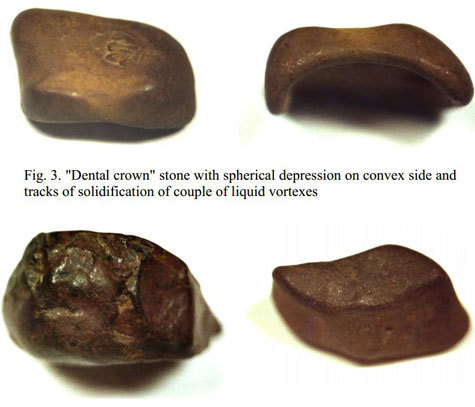probably after 105 years have found the first fragments of the Tunguska meteorite
Russian geologist State Geological Museum. Vernadsky RAS (Moscow) Andrei Zlobin claims that gathered more than 100 stones that look like part of a meteorite from the river bottom Kuzhmy during an expedition to the site of the explosion, which took place in 1988. And since then, the analysis of the fragments were not for a reason that explains the scientist. Preprint articles describing posted a scholar stones found in the archive at Cornell University (USA).
in 1988 during an expedition to the site where a bomb blast historical scholars interested in the so-called Suslov’s crater, which is a quagmire of more than 30 meters in diameter, which is close to the epicenter of the strange event. Scientist admits that on its territory and could be pieces of the cosmic body.
In the area of ??peatlandsSuslov funnel arranged layers that show disaster. But the search operations have been unsuccessful – fragments of the meteorite has not been found. And then drew attention Zlobina Hushmy river bed, which could also keep the debris of unknown breed. And the scientist has found what he wanted. Specialist delivered to Moscow many interesting specimens and “forget” about them for a long quarter of a century.
Zlobin writes that in favor of extraterrestrial origin found the wreckage said that they all melted, have traces of heat and shock, as well as have a “rusty” color, which indicates the high content of iron. However, a full chemical analysis of fragments, unfortunately, not been conducted.
scientist published his work on the west site of preliminary scientific publications arXiv.org. But many researchers are confused by the fact that Zlobin demonstrated his sensational finds only twenty-five years after the expedition.
Some Russian scientists have considered the application of the Tunguska phenomenon researcher Andrew Zlobina the find fragments of the Tunguska cosmic body baseless, “Even if we assume that he found the stones really meteorites (which is not yet proven), we still have to prove that it is fragments of the Tunguska. Meteorites the world is full of, for more than 100 years have passed since the fall of the Tunguska cosmic body in the area has fallen meteor dust and small meteorites larger than the mass of the body itself, “- said Natalia Artemiev of the Russian Academy of Sciences Institute of Geosphere Dynamics.
Artemyev surprised that Zlobin tried to geochemical analysis of the fragments: “This is ridiculous, not by appearance of stone to say that it was a meteorite. geochemistry only we can say something about the nature of the meteorite. This is elementary enough to come the Institute (of Geochemistry and Analytical Chemistry) Vernadsky where investigate meteorites, “- said the scientist.
Signs that Zlobin cites as evidence of meteorite nature, do not stand up to scrutiny, Artemyev said: “In the meteorites are no vitreous cortex, they do not happen quartz, as evidenced Zlobin”.
 | ||
| fragments of the Tunguska meteorite. Photo: technologyreview.com |
“Pieces of meteorites can be found everywhere and always. fragments Search Tunguska body to where there is a very good stratigraphy (good dating geological layers.) not in Siberia, but somewhere in Greenland, where we can clearly say that this ice layer refers to the year 1908. If we find something there, then we can say that it was the Tunguska “- said Artemyev. She noted that the stones in the river bed can be brought anywhere.
Tunguska catastrophe took place over 100 years ago in the Stony Tunguska River basin, in the Evenki. June 30th, 1908 at 7:14 am local time flew and blew a fireball. The expedition, to get to the disaster area in 1927, found fallen timber on an area roughly equal to modern Moscow, but at the blast site was not found any trace of the fall or the wreckage of the cosmic body. The next expedition Kulik in 1930 returned with a fragment fused glassy rocks containing gas bubbles. But the sample was lost somewhere and has not been subjected to analysis by modern methods.
For many years of searching has not been found even dust particles that could be confidently attributed to the substance of the Tunguska object. According to the most common among scientists version, the explosion was caused by the entry into the atmosphere of ice comets, most of the material which has evaporated. But there are also extravagant hypothesis: in 1908, broke away from the Earth’s white hole.
most curious that none of the pre-revolutionary scientist or just a seeker did not go to the place of drama on hot traces the disaster immediately after the events of 1908. And the first survey of the Soviet authorities had been only 19 years later: the first expedition to the crash site was established in 1927. From 1927 to 1939, the Soviet researcher Leonid Kulik arranged in place of the dramatic events of 1908, several expeditions, the use of which was to collect more evidence than in the detection of material evidence. A key finding of the seekers of years, according to his daughter L.Kulika, detection can be considered in place of “falling” radial tree fall with baked central part (see photo below). But it was after the expeditions Kulik, when already at the crash site to drill the soil and no sign of a meteorite found was never brought a wealth of skeptics who questioned the general strangeness of the phenomenon.

Sources: arxiv.org , popmech.ru , RIA Novosti , Lenta. ru , news-mining.ru , astronews.ru , wikipedia.org , newslab.ru .
See also Riddle M-sky triangle. Photojournalism-research world-famous anomalous zones “.
No comments:
Post a Comment